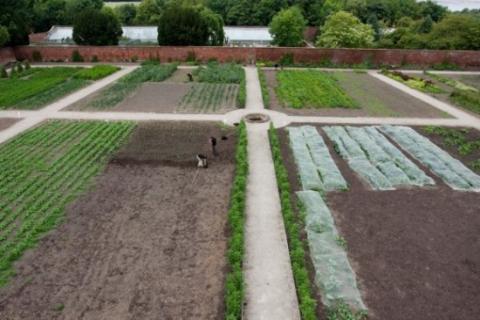Mostyn Kitchen Garden Project Introduction
Site: Mostyn Kitchen Garden
Address: Mostyn Hall, Holywell
Technical Officer: Debbie Handley
Project Title: Developing a Pick You Own Pumpkin Enterprise Case study
Introduction to project:
Mostyn Kitchen Garden is a Victorian walled garden set in the grounds of Mostyn Hall in Flintshire. There is a large orchard and the 2.5 acres are used to grow a wide range of fruit and vegetables including berries, rhubarb, tomatoes, beetroot, beans, herbs and salad crops. Focussing on making the most of added value, much of the produce is frozen at harvest and made into jams, chutneys and throughout the year for sale through local farm shops and small retailers.
Figure 1. Aerial view of the walled garden
There is increasing public demand for outdoor experiences, which has intensified over the Covid-19 period, and developing a pick your own (PYO) enterprise is an ideal way to tap into this demand. Growing pumpkins for Halloween can potentially be a very lucrative source of income, but requires careful management to achieve production and clearance of the crop to meet a given short harvest window. On the plus side, pumpkins can be easily managed alongside routine farming activities and require limited additional labour input.
Project Objectives:
The main aim is to explore the financial benefits of establishing a small scale PYO pumpkin enterprise and to evaluate any additional benefits from engaging with the local community such as increased sales of other produce and raising profile on social media.
The project will focus on:
- Choice of varieties considering colour and size requirements
- Comparing growing from seed indoors with direct planting outdoors
- Optimum planting density
- Providing the correct nutrient balance
- Weed control
- Recording any disease issues especially Blossom End Rot
- Determining whether irrigation is required
Key Performance Indicators:
To provide knowledge on:
- Overall margin over costs
- Labour and time inputs
- Comparing sowing undercover and direct planting
- Public/community engagement
Timeline and Milestones:
January 2021 - Research suitable pumpkin varieties. Measure land area for planting and to work out quantity of seeds needed.
February - Consultancy on soil nutrition/soil testing
March - Bed cultivation to start if weather permits.
April - Bed cultivation. Stale seedbed technique.
May - Stale seedbed technique. Sowing in modules under glass. Direct drilling and fleecing. Maintain seedlings under glass. Final preparation of ground for planting.
June - Planting out during the last week of May or first week of June depending on the growth of plants and weather conditions.
July-August - Monitor weeds, disease and irrigation where required. Hoeing at first sign of weeds.
September - Commence social media campaign to encourage interest from the public. Monitor crop for mildew, etc. Consider treatment with consultant advice. Plan access, parking, signage, toilets, sales area, payment arrangements, staffing, equipment and any booking system for the PYO enterprise.
October - Start PYO, consider adding value to the experience (e.g. pumpkin carving, toffee apples, pumpkin soup, tea/coffee and cake, jams/chutney sales). Consider if any pumpkins need to be moved under cover.
November - Calculate percentage of crop left post Halloween. Clear ground for winter and sow green manure if warm enough. Sell any leftover crops or donate locally.
December - Final review and costings

